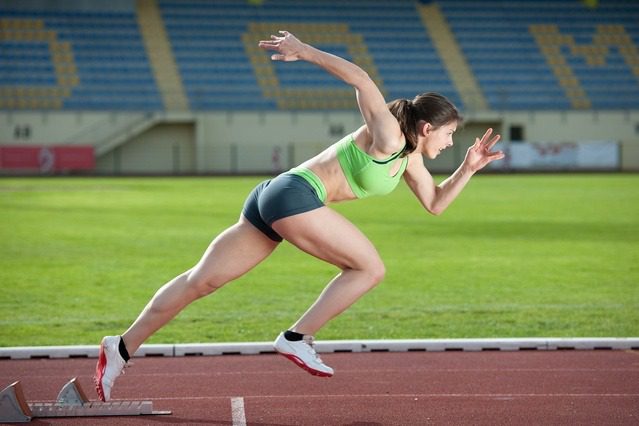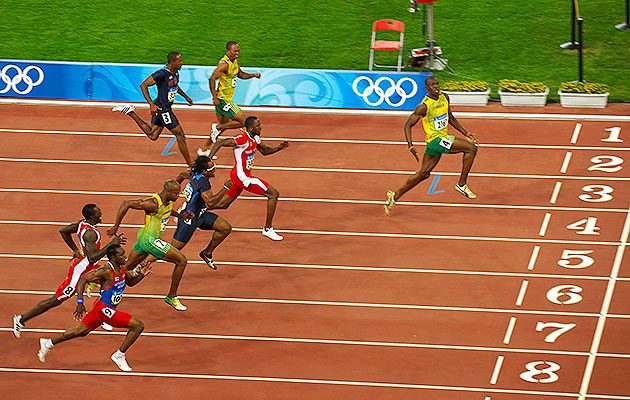3 Speed Training Methods That Don’t Work (And What To Do Instead)
Speed & AgilityABOUT THE AUTHOR

Joel Smith
Joel Smith, MS, CSCS is a NCAA Division I Strength Coach working in the PAC12 conference. He has been a track and field jumper and javelin thrower, track coach, strength coach, personal trainer, researcher, writer and lecturer in his 8 years in the professional field. You can connect with Joel on his website.
In the realm of getting fast, there are lots of proposed fixes… lots of things that “look” like they are training speed. But in the end, not as many things truly work as well as they say.
One thing coaches generally don’t respect enough is the ability of the human body, an organism with more computation power than our best machines, to put together movement that uses the best of what the body has to offer.
For some reason, many coaches look at athletes and think they hold the “magic keys” to fix speed and movement ability, yet so many high school track and field records on the state and national level are still found from the 1980s and 1990s. Isn’t all this coaching helping?


So why is this the case? There are a lot of “training” methods embedded in our sport culture that are accepted as somehow making an athlete faster, but in reality, the potential of these methods to improve speed are based off of false premises – these two in particular:
- Everything should be straight “front to back” and focused on right angles in sprinting to avoid wasting movement and allow for “prettier looking” running.
- Vertical force production and getting the knees parallel in front of the body is the most important component of getting fast (this allows the “validation” of floor-based weight room work to this end, despite a lack of horizontal velocity).
I often see coaches looking to improve speed through 3 coaching and training means that have serious shortcomings. As with anything, criticizing is easy, but offering solutions is the key.
So this article will discuss commonly applied speed training techniques that lack ability to get results, and will also list alternatives that can be more effective.
The three misapplied speed training methods are:
- Marching style sprint drills: A-skips, B-skips, etc.
- Seated Arm Swing Drills
- Sled Pushes *For improving tri-planar speed and hip projection*
// S1. March Style Sprint Drills (A-Skips, B-Skips, Etc.)
Go to almost any training facility and watch almost any team practice or warm up, and most of all, go to any track and field meet. You’ll see a plethora of “marching” based drills designed to improve speed. These drills are known as “A-Skips” and “B-Skips” – along with many derivatives such as “C-Skips” and various single leg versions.
At the end of the day, these drills are only good for warming up and then their original use: conditioning the sprint muscles via high volumes in cold weather environments when outdoor running was not an option and nice indoor tracks were not common.
In this case, a creative coach, Gerard Mach, came up with a number of exercises designed to replicate particular actions in sprinting in a very vertical and rhythmic manner.
In terms of being able to do something that looks like sprinting and get basic muscle condition in tough times of the year, this is definitely a viable option. But remember, these drills were done at maximal intensity for a fairly high volume in their original format, and this was primarily to have something to do in a small amount of space.
Here is the problem: because these drills look like pieces of sprinting, modern coaches look at them as a shortcut or tool to teach good running habits, which is the farthest thing from the truth with this type of work. In terms of direct transfer to sprint mechanics and fast running, there are serious problems (both of which I learned from coach Adarian Barr):
1. These drills have nothing to do with the timing that happens in sprinting.
The knee drive in sprint drills is artificially high…if athletes were to run like that when actually sprinting, it would cause a highly awkward run that is completely mistimed.
The knee can only rise as long as the stance leg is pushing, and if it continues to rise beyond the point where the stance leg pushes off, this causes massive compensations and slow-downs in running.
When watching athletes do A-skips and B-skips, all you tend to see is mistimed frontside mechanics.
2. March based drills are always balanced and sprinting by nature is Imbalanced.
Being imbalanced means that the center of mass is ahead of the foot and knee at pushoff. With the foot well behind the hip, the athlete is now in a place where the pushing action of the leg can propel the athlete forward. Being balanced means that the foot is below the center of mass, and it can only push the athlete upwards.
Check out the still frame below that show the difference between a skip-drill position and a sprinting position.


Usain Bolt (front) demonstrating the fundamental position of pushing in sprinting, with the foot positioned behind the hips via a bent stance knee. March style sprint drills do nothing neurologically to help with the sync between this and the parallel front thigh position.
Again, sprint drills were used in cold weather areas, like Poland, to be able to condition specific sprint muscles in times of need and large volumes were applied to do so. Today, coaches will do a few reps of 10-20 meters, tell kids to lift their knee and toe, and think they are doing athletes a service.
At the end of the day, it is no wonder that Joe DeFranco got kids significantly faster than the local speed school that taught 9-year-olds how to do B-skips, using only a 500-foot storage closet, weights, and jump boxes.
Do instead: Mini-hurdle runs
Mini-hurdles are a fantastic training tool that can be used in many ways to improve an athlete’s linear speed.
To perform a standard mini-hurdle run, place 6-10 small hurdles between 4 and 6 inches in height between 5′ and 7’6” apart, depending on your athlete’s ability level. To check out a simple way to estimate optimal stride lengths based on how fast your athletes are running, check out this article by Curtis Taylor of Oregon University.
Mini-hurdles have been proven by research to instantly improve an athlete’s sprint speed, and work by helping athletes to retract the push leg into a swing position faster and subconsciously. This retraction to the front generally results in better frontside mechanics, but without compromising how well an athlete is putting force into the track both horizontally and vertically.
// 2. Seated Arm Swing Drills
In all my years of coaching, there is one very common instruction I now see as a cardinal sin when instructing athletes. It is the epitome of a profession that seems driven to over-coach athletes… and that is in arm mechanics and fixed swinging at 90 degrees in the sagittal plane.
Nice idea, but nobody fast actually runs with their arms like this.
The seated arm swing drill sets young athletes up for upper body failure in running more than any other taught movement. As the legendary coach Charlie Francis once mentioned, a large part of coaching is actually “unteaching” things that coaches needlessly instructed to athletes early in their development.
Why is this drill a bad idea? One simple reason is the fact that arms don’t stay at 90 degrees during running; in fact, the elbow angle is constantly changing!
When the arms are down by the hips, the elbow will often be close to fully extended. I first heard of this idea from watching a Dan Pfaff lecture, in which he noted an anecdote of a female who dropped .30 seconds off her 100m dash by undoing her “locked at 90” arms she picked up as a young athlete.
By keeping the arms fixed at 90 degrees, athletes will find their timing disrupted, and the maximal power capacity of the arms to counterbalance the legs reduced.
Watch literally every sprinter in this race. Anyone keeping their arms locked at 90 degrees the entire run? Anybody? Why do we think fixed at 90 degrees is somehow proper form??
Do instead: straight arm drills and leaving athletes alone
So what should we be doing instead of teaching athletes this 90 degree, seated arm swing nonsense?
For one, nothing is often better than messing with athletes in this regard. Many athletes will have great arm mechanics on their own. In fact, I see this in young sprinters all the time, age 8-12, who have perfect arm mechanics, until some coach thinks they have to “teach” them the right form.
Outside of this, I do like straight-arm running and straight-leg bounding drills, since these help athletes feel the inherent power at the bottom of arm stroke, as well as create a greater torque moment for their core and shoulders to stabilize.
Finally, the last fine-tuning of the arms I learned from Adarian Barr, and that is the wrapping of the wrist on the backswing and its unwinding into the front swing of the arm motion. Arm swing isrotational, not purely performed in the sagittal plane!
This subtlety of the wrist is actually a crucial key player in virtually any powerful athletic movement, and you can see it in action in the sprint video above.
// 3. Sled Pushes
The last speed training tool that appears to be a holy grail, yet has some significant drawbacks is the beloved sled push.
I list this one as being under effective, rather than ineffective, as it can be useful, particularly in short acceleration situations. But there are much better options in consideration of an athlete’s race-speed potential.
Although a favorite of football strength coaches and CrossFitters alike, the sled push has a couple issues that prevent it from transferring well to good sprinting.
1. It is quite difficult to attain truly good posture when actually sprinting and pushing a sled forward.
In many scenarios, athletes will round their upper backs while pushing in an attempt to bear down on the sled, especially as they get tired. It is possible to march and push a sled forward keeping the spine in a good alignment, but this is a very regressive movement with limited transfer. It is also possible to run at moderate to fast speeds with good posture on a sled, but to run all out often calls for a more head down rounded position.
Athletes can very easily fall into sub-optimal postures when sprint-pushing sleds.
2. The second drawback is something I picked up from coach Adarian Barr and that is the inherent limitation of shoulder rotation that fixing the arms on a sled has.
Acceleration in track and field or team sport relies on a couple key facets of the upper body, shoulder rotation, and getting the head over the foot.
Watch any powerful athlete accelerate, and you’ll see that there is significant movement in the frontal and transverse planes in the shoulders, as the athlete must make the most out of both torque and balance to propel themselves forward. In sprinting, the shoulders and hips are linked, as are the hands and feet.
See how the sprinters in the video below make maximal use of subtle shoulder rotation and maximal arm projection to help drive the push leg.
In good acceleration, an athlete’s head will actually find itself over the touchdown foot (known as “head over foot”). There is a ton of movement happening in the frontal plane in acceleration.
Check out the video below featuring some smokin’ fast sprinters coming out of blocks to see what I mean.
All this to say, sled push work can be helpful when the hip projection of an athlete is fairly small, say running just a few short steps, or perhaps up to 10-15 yards which can be impactful for team sports.
The longer the run, the more important it becomes to achieve longer projections of the hips in conjunction with the shoulders, and this is where sled pushes will negatively impact the athlete, which is likely why you’ll never see good track coaches performing these with athletes.
In preparing athletes for tests such as the 40-yard dash, the same rule would also apply.
Do instead: sled-resisted town sprints
A simple drill that has been time-honed by the Jamaicans, as well as researched to have effective potential in recent years, has been heavy sprint pulls.
In pulling a sled via a harness, the arms and shoulders are free to move naturally and in sync with the hips and legs to maximize their output in hip projection.
Anecdotal work by great coaches such as Scott Salwasser and Cameron Josse with heavy slow tows have yielded incredible results, such as .3 second drops in an athlete’s 40-yard dash.
See below for a video of this effective speed training method. When I utilize this method, I prefer to use timing gates for maximal output if possible.
Generally speaking, the sled should be heavy enough to cause an athlete’s maximal speed in acceleration to decrease about 50%.
// Conclusion
Although you may detect a bit of a 40-yard dash and track speed bias to this collection of speed training flaws and alternatives, they reflect preparing an athlete to express natural movement in sprinting, and maximizing the pathways behind that movement.
Even if you are a stretch coach training athletes primarily interested in acceleration under 20 yards, it is my hope that this article provides you with some extra insight on the emphasis and insight behind these popular training methods and how to optimally steer the course of speed preparation.
Are you a better coach after reading this?
More coaches and athletes than ever are reading the TrainHeroic blog, and it’s our mission to support them with useful training & coaching content. If you found this article useful, please take a moment to share it on social media, engage with the author, and link to this article on your own blog or any forums you post on.
Be Your Best,
TrainHeroic Content Team
HEROIC SOCIAL
HEROIC SOCIAL
TRAINING LAB
Access the latest articles, reviews, and case studies from the top strength and conditioning minds in the TH Training Lab

